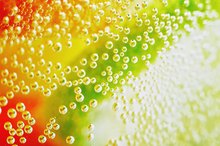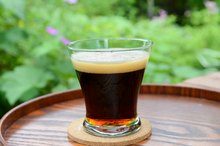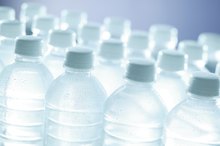Diet Tonic Water Vs. Regular Tonic Water
Quinine, a chemical extract from the bark of Peru's cinchona tree, is the active ingredient in tonic water. When India was part of the British Empire, tonic water was the preferred method of delivering the malaria-fighting protection of quinine to British troops and colonials. The Indian experience also produced a mixed drink -- gin and tonic, which helped to mask the bitter taste of quinine and made fighting malaria a little more pleasant. The calorie profile and carbohydrate content are the main differences between regular and diet versions of tonic water.
Sweeteners
Quinine's bitter taste would make tonic water unpalatable for most people without added sweeteners. High fructose corn syrup is a commonly used sweetener in regular tonic water. This sweetener frequently replaces granulated sugar in many food-manufacturing settings because of its lower cost per ounce of liquid. Manufacturers use artificial sweeteners such as saccharin, aspartame or sucralose in diet tonic water.
Regular Tonic Water Calories
Nutritional Value of Diet Tonic Water
Learn More
The standard retail can of tonic water contains 12 ounces. Although you might consume less when you use tonic water as a mixer, many consumers drink tonic water as an alternative to flavored sodas, colas and bottled waters. Each 12-ounce serving of regular tonic water contains 124 calories, according to the U.S. Department of Agriculture. The carbohydrate content of regular tonic water is 32 grams per serving; all of it comes from the added sweetener.
Diet Tonic Water Calories
Schweppes and Canada Dry diet tonic water are commonly available in the U.S. Both report that their brands of diet tonic water contain 0 calories per 12-ounce serving. These manufacturers use saccharin to sweeten their diet version of tonic water. Non-nutritive or calorie-free artificial sweeteners do not contain carbohydrates.
Considerations
Calories of Guinness Stout Beer
Learn More
Often confused with other clear, fizzy beverages, such as club soda and seltzer water, tonic water is the only carbonated water in the U.S. that contains quinine. The U.S. Food and Drug Administration regulates the production of tonic water, and limits the quinine content in retail brands to 83 parts per million, according to the Ask Dr. Knowledge column on Boston.com. Unlike the original formulation, a 12-ounce serving does not contain enough quinine to have any medicinal benefit. Regular and diet tonic water also contain sodium. The amount of sodium in one serving of regular tonic water averages 2 percent of the recommended daily maximum for healthy adults, or 44 milligrams, according to the USDA. Schweppes diet tonic water has 95 milligrams of sodium per serving, which equals 4 percent of the recommended daily maximum. Canada Dry diet tonic water contains 80 milligrams of sodium per serving, or 3 percent of the daily value.
Related Articles
References
- Boston.com: What is Tonic Water?
- U.S. Department of Agriculture: National Nutrient Database for Standard Reference, Release 24 - Nutrient Data for 14155, Carbonated Beverage Tonic Water
- Schweppes: Diet Tonic Water
- Dr. Pepper Snapple Group: Diet Canada Dry Tonic Water
- Nation Public Radio: FDA Rules Corn SyrupCan’t Change Its Name to Corn Sugar
Resources
Writer Bio
Carol Luther has more than 25 years of business, technology, and freelance writing experience. She has held leadership roles in higher education management, international development, adult education, vocational education, and small business support programs









